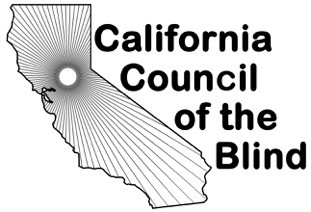Susan Glass, Associate Editor
[Editor's Note: We're inaugurating a new column in this issue of the BC called "Chapter Spotlight." Its purposes are many: to increase awareness of, and
networking among our various CCB chapters; to share strategies for growing membership and for fund-raising; to celebrate chapter accomplishments and achievements
of individuals within chapters; to deepen our knowledge of CCB's history throughout the state; to promote projects that advance the personal and professional
well-being of blind Californians. Each BC will feature a different chapter, and we'll alternate between profiling chapters from the northern and southern
parts of the state. Let's begin our tour in Orange County.]
Ask third-time chapter president Andrea Pitsenbarger what she most celebrates about her Orange County constituents, and the sound waves sparkle with her
enthusiastic reply.
"We have an excellent, hard-working board, and many of our chapter members are professional people. At least two work in technology fields, and two are
retired social workers. Having professionals in your membership can encourage blind people who want careers but appreciate a bit of mentoring."
It turns out that blind professionals have lead the Orange County chapter since its founding by Coletta Davis in 1986. Bonnie Rennie, who joined the chapter
in 1989, fondly remembers a number of seminars organized by then President Davis.
"Coletta Davis at one time worked for the governor of Hawaii as coordinator of disabled services," says Bonnie. "She had a knack for convincing people
to come speak to us about relevant issues, and she had many contacts at the Braille Institute and other local organizations. She'd organize these day-long
dress-up affairs where chapter members would gather to learn things: education, legislation, interviewing. She mobilized people. In the earliest days,
she even held chapter meetings in her home."
The Orange County chapter has enjoyed strong leadership ever since, and both Andrea and Bonnie describe it as a powerful chapter where camaraderie abounds.
Another strength, says Andrea, is a fund-raising strategy that the chapter has adopted. "We network with other organizations in our community who are also
having fund-raisers. Certain of our chapter members know people at the Braille Institute, AA and a number of senior centers. They are our points of contact.
We attend events sponsored by their organizations, and they in turn attend ours. We just completed a fund-raiser at Chilis Restaurant in Anaheim. We called
it a "give back" night. People purchased a meal, and a certain percentage of their bill was donated back to the chapter."
Currently CCB's Orange County affiliate has 19 members. Each quarter features one meeting dedicated to a speaker, panel or presentation, one special event
or field trip, and one business meeting. In October, for instance, a contact from The League of Women Voters addressed the chapter on the upcoming election,
its candidates it its issues. Another meeting found members visiting a local bird sanctuary. Some meetings combine chapter business with a speaker presentation.
Bonnie recalls that past meetings featured what she called member driven "corners." A book corner for instance, would be a meeting where members discussed
a book they'd all read, or recommended titles to one another. A tech corner would be a meeting where people shared their latest technology, and a hobby
corner would be a meeting or portion of a meeting dedicated to members sharing personal interests.
I asked what projects President Pitsenbarger hopes her chapter might undertake, and she replied that she'd like to see them campaign for more audio described
films in more theaters. She'd also like to raise the sighted public's awareness of audio description and its benefits.
"What does your chapter need most," I asked both Andrea and Bonnie, "And how can CCB help your chapter meet that need?"
"We need to recruit younger members," said Andrea. "We, along with the rest of CCB, are an aging organization. On both local and state levels, we need
to evolve ways of attracting upcoming generations of blind and visually impaired people."
Bonnie agreed. "We've got to find issues that interest potential new members. We need more communication throughout the state. It might help individual
chapters if there were regular presidents' meetings, and chapter presidents brought information from those meetings back to their respective chapters.
Members in local chapters need to learn more about what CCB committees do."
Both Andrea and Bonnie thanked CCB and the Orange County affiliate for connecting them to a blind community. As children and college students, they had
received a mainstream education, and spent much of their adult life with sighted people.
"CCB offers connections to blind friends from the past," said Andrea, "as well as opportunities to forge new friendships and professional relationships."
"CCB has done so much for me," said Bonnie. "They gave me a scholarship when I was a student, and there was even a student chapter one year when I was
in school. CCB taught me much about self advocacy. That's what people who aren't members now need to understand: what CCB has done for so many already,
and what it can do for them."


